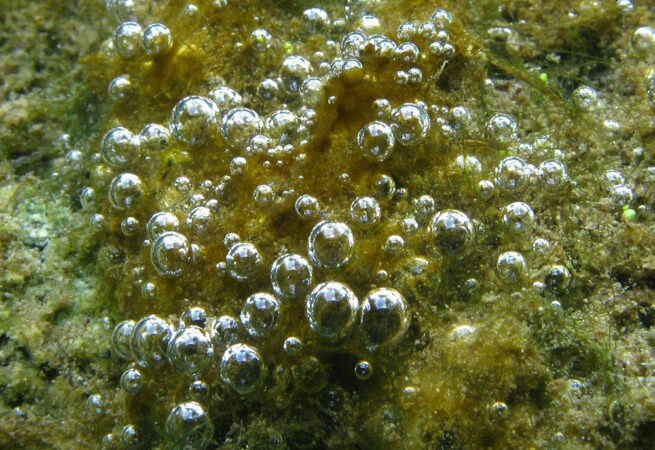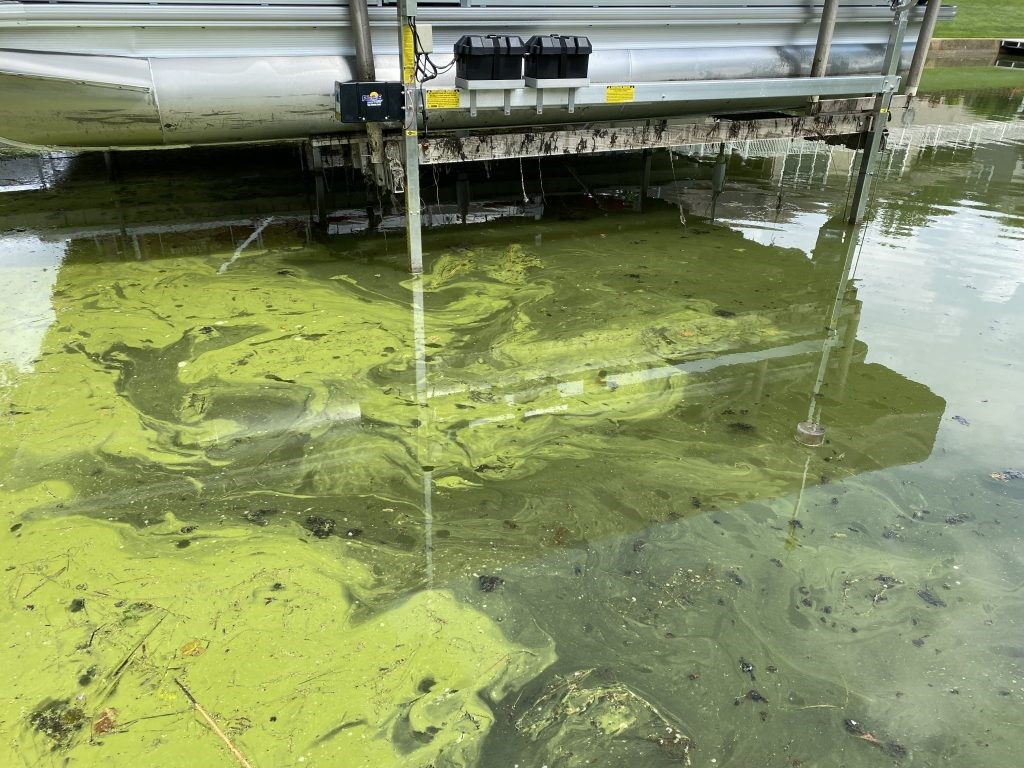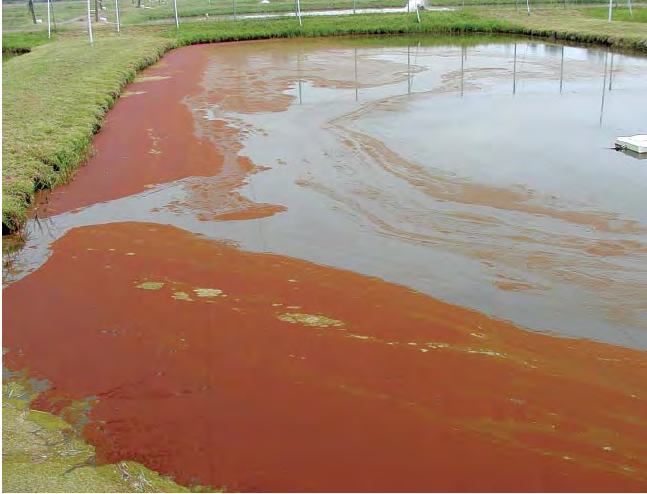Algae are a large and diverse group of protists consisting of one or more cells with simple structures, different colors, always containing chlorophyll but without roots, stems, or leaves. In the world, 5 common algae in ponds include Diatoms, Green algae, blue-green algae, Eye algae, and red algae.
In aquaculture, algae are a common factor about greatly affecting the quality of the farming environment. The role of algae in aquaculture is divided into 2 types: Beneficial role about providing nutrition, regulating oxygen concentration in water. Besides, about harmful role, they will occupy oxygen, produce toxins into the water, cause disease and even death to aquatic animals. Therefore, recognizing and understanding the characteristics of each type of algae to have appropriate treatment options plays a very important role, contributing significantly to the success of aquaculture.
I. DIATOMACEOUS EARTH (SILICA ALGAE)
Diatoms, also known as sand algae, silica algae. In nature, diatoms play a very important role in the biochemical regulation of the ocean. Diatoms absorb carbon dioxide (CO2) and sunlight to produce oxygen, which is like a biofuel factory. When diatoms predominate they give the water a yellow-green or yellow-brown color.

Benefits:
– Diatomaceous earth complex is a novel nutrient blend that helps stimulate the growth of aquatic organisms.
– Live feed from this nutritional mixture helps sustainable growth, disease prevention and maximum yield.
– Reduce toxic ammonia and heavy metals, and prevent the growth of unwanted filamentous algae in the water body.
– Diatoms also act as a biological filtration system in the aquatic environment, helping to stabilize environmental parameters in the pond.
– Compete for nutrients and reduce pathogenic bacterial populations. more
II. GREEN ALGAE (CHLORELLA ALGAE)
Green algae (chlorella algae) is a type of algae that is non-toxic, very small in size and does not cause odor to animals in the pond. Their composition contains many types of amino acids, calcium, zinc, iron, fiber, vitamins and especially up to 60% protein. Therefore, this is a nutritious feed source for the development of shrimp and fish. Green algae determine the color of pond water, when it develops dominantly, it will make the pond water light green (green of young banana buds).
Benefits:
– A very good natural feed source for the growth of shrimp and fish.
– They are a rich source of oxygen thanks to their daytime photosynthesis.
– Some species of green algae also have the ability to produce substances that inhibit the growth of Vibrio bacteria.
– When green algae grows to an acceptable level, it will partially cover the pond surface from direct sunlight, helping to maintain a stable water temperature at the bottom of the pond.
– Contributes to limiting the growth of toxic algae.
– The growth of green algae in shrimp ponds will reduce water clarity, absorb organic matter and excess nutrients in the water.
III. BLUE-GREEN ALGAE (CYANOBACTERIA)
They are also known as cyanobacteria. This type of algae is aquatic and creates its own food (autotrophic). Normally, people can easily find blue-green algae in a variety of water environments from salt water, fresh water to brackish water. When blue-green algae grow and dominate, the pond water will be dark green, with a green scum floating on the water surface, especially floating in clumps at the end of the wind during hot sunny days.

Harmful effects:
– Blue-green algae are very easy to grow, too high a density of blue-green algae will block sunlight, preventing the photosynthetic ability of many other beneficial algae.
– The strong outbreak of blue-green algae (algae bloom) leads to competition for resources in the pond such as nutrients or oxygen. Because the growth rate of blue-green algae is much faster than that of shrimp and fish, the amount of oxygen in the pond will quickly decrease, leading to a lack of oxygen.
– A severe drop in oxygen levels will cause other algae or other organisms to die off. This can lead to the accumulation of toxic compounds such as ammonia, nitrite, and hydrogen sulfide.
– Blooming algae will create slime that sticks to the gills of shrimp and fish, preventing them from breathing. More seriously, if eaten, it will be difficult to digest and the blue-green algae will secrete toxins that can lead to many dangerous diseases.
– Blue-green algae produce many toxins that are harmful to nerve cells, liver, intestines of shrimp and fish. Toxins secreted from blue-green algae are divided into three groups: liver toxins, nerve toxins and cell toxins (Cytotoxins – Cyto means cell).
IV. EUGLENOPHYTA
Eye algae are indicators of organic pollution in the environment, they live in eutrophic environments. Eye algae are mainly distributed in freshwater bodies, a few species live in brackish water.
The appearance of algae in the pond indicates that the pond bottom is starting to become contaminated. In intensive farming, it is due to excess feed. In low-feeding models, when this group of algae appears, it is due to polluted water or pre-contaminated pond bottom.
When algae are dominant, the pond water will be dark brown or dark green. Algae affect the dissolved oxygen content in the pond. When they are dominant, they can cause shrimp and fish to lack oxygen, causing them to float and swarm.
In favorable organic conditions, algae increase their biomass very quickly, affecting the dissolved oxygen content in the pond and further contaminating the pond water environment.
Because eye algae is a toxic algae species for shrimp ponds, their appearance creates disadvantages:
– Secretes toxins that cause liver necrosis in shrimp
– Competition for oxygen with shrimp and fish
– Algae pollute pond water.
– In addition, fish that eat dead algae can easily cause intestinal diseases, slow growth and affect crop yields.
V. DINOFLAGELLATES | RED ALGAE (PYRROPHYTA)
This algae is filamentous, has flagella and exists mainly in unicellular form. Thanks to the flagella system around the body, dinoflagellates move very quickly. The cause of the appearance of dinoflagellates is often due to:
– Dinoflagellates already exist in the water source taken from an external source. When introduced into the pond, under favorable environmental conditions, dinoflagellates will rapidly explode.
– The difference in content between macrominerals and trace minerals causes an imbalance in the total mineral content in the pond, especially Phosphorus.
– The pond bottom has an accumulation of Phosphorus and Nitrogen elements, leading to high levels of pond pollution, which is a favorable condition for dinoflagellate outbreaks.
– Pond water with dinoflagellates will tend to turn dark brown, even reddish brown.

Harmful effects of dinoflagellates:
– Due to their characteristic thorny shape and angular body, when entering the shrimp’s intestines, their hard armor (cell wall) will press very tightly into the shrimp’s intestinal wall, causing intestinal obstruction and destroying the shrimp’s intestines (causing intestinal rupture).
– When algae die, their bodies will cause a large amount of toxic gas NH3 , causing the shrimp to be attacked by toxic gas, causing phenomena such as shrimp swimming lethargically, not eating, dropping meat, etc. At the same time, these factors also cause a large difference in pH between day and night, causing shrimp stress.
– The strong oxygen absorption capacity of dinoflagellates causes shrimp to compete for oxygen, leading to a serious decrease in dissolved oxygen concentration in the pond.
– Dinoflagellates also cause the pond water to glow, greatly affecting the living habits of shrimp and fish.
To prevent the problem of toxic algae growth, farmers should manage the amount of feed better to avoid excess feed creating conditions for algae in shrimp ponds to grow excessively.
